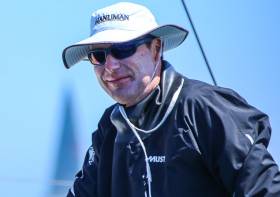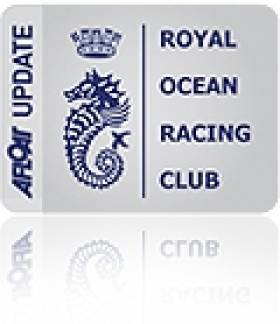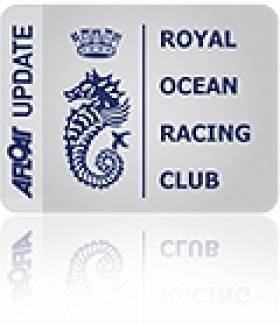Displaying items by tag: Niall Dowling
Niall Dowling is July 'Sailor of the Month' (Offshore)
The achievement of Niall Dowling of the Royal Irish YC in taking both Line Honours and the Overall Win in Wicklow’s Volvo Round Ireland Race 2018 with the Ker 43 Baraka GP is put into its proper perspective when we remember that at the halfway stage, Baraka was way down the rankings despite a tactically brilliant performance.
Until then, conditions had been completely stacked against her, such that off the coast of Mayo, she was in lowly 24th overall. But then things started to turn in her favour, with brilliant tactics and sailing to take the fullest possible advantage of the slightest helpful slant. Having had a mountain to climb, they climbed it at speed and then skied down the other side to a runaway victory.
Royal Irish Yacht Arabella Takes Three RORC Awards
The Royal Ocean Racing Club in London has awarded Niall Dowling's Royal Irish yacht Arabella (a J111) the Alan Paul Trophy for consistent high performance in IRC, the Serendip Trophy for best series-produced Yacht in IRC, and the second place medallion in IRC overall for the 2011 RORC season.
Irish boats Post Mid-fleet Results on the Solent
There were mid fleet performances from Irish boats at RORC's Easter Sailing Challenge on the Solent where competitors not only head home wiser after three days of coaching, but also with suntans...so the July-like conditions continued for Easter Sunday, the final day of competition.
Royal Cork's Anthony O'Leary was fifth from ten starters in IRC one and Niall Dowling's new J111 Arabella finished the same in IRC 2. Both boats moved up from sixth overall in yesterday's final day of racing.
Racing got underway in the morning with just enough northwesterly gradient coming out of Southampton Water for the race committee to set courses to the north of Ryde Sands. The first race was held in 5-10 knots while in the second, the breeze dropped off after the second start.
Despite a protest over their start in today's second race that might have cost them the top spot, Rob Gray and Sam Laidlaw's Farr 52, Bob, won IRC 1 by a comfortable four points, the biggest boat in the RORC Easter Challenge fleet benefitting from clear air in the light winds.
Mike Bartholomew's King 40, Tokoloshe, had a disappointing day posting two fourths, dropping them to second. "It was thoroughly enjoyable, a great regatta, although it was a pity the wind got a bit fickle at times," said the South African skipper. "I think it was quite funny that we are one of the lowest rating boats in our class and we ended up second while the top rating boat won. There has been a lot of criticism of the IRC, so maybe it works! And the weather was beautiful. I don't live here all the time, but I have never seen England so good."
Mark Devereux's Club Swan 42, Brevity, slipped into third today after the British Keelboat Academy's Farr 45, Kolga, was OCS in today's second race. Kolga has British Keelboat Academy crew with RYA Youth Match Racing National Champion Mark Lees, 19, steering.
"For us it was a case of our making sure that all the fundamentals we've been working on in the manoeuvres and the communications on board were all clicking," commented British Keelboat Academy Head Coach, Luke McCarthy. "In the first race today it all came together and it was nice to get second on corrected in a pretty competitive IRC fleet."
In IRC 2, RORC Commodore Andrew McIrvine was in his stride, scoring two wins aboard his First 40, La Rèponse. This left him tied in first with Andrew Williams' Prima 38, Max 'Ed Out! which won having one more bullet.
The scorers also had to resort to countback in IRC3 where Chris and Hannah Neve's First 35, No Chance, was pipped at the post by Louise Morton's MAT 1010, which had two wins today to gain the all-female crew (apart from Volvo Ocean Race winner navigator Jules Salter) the overall prize on countback.
No Chance's tactician Phil Lawrence, grumbling that his match racer daughter Charlotte aboard MAT 1010 had beaten him, said that in the second race their chances were scuppered when they got gassed by the J/109, Toe in the Water, led by round the world sailing legend, Brian Thompson. "There was much less breeze and we are not so quick in that and Toe In the Water, which has been sailed really well, got past us and dropped us back into the pack. We could just never catch them."
The regatta's only run-away leader was Grant Gordon's J/97 Fever. She finished 16 points ahead of Robert Baker's X-332, Brightwork, despite losing today's final race to Alistair Evans' immaculate Swan 37, Alvine XV, winner of the Prix d'Elegance (as chosen by the ladies on the committee boat).
Following on from Gordon's Swan 45 of the same name, the J/97 is being sailed by a new team that has been together since last Cowes Week.
"It has been very well organised by the RORC," continued Gordon. "They have done a good job and it is great to get feedback from the coaches. We got some good input on trimming the sails from Eddie Warden Owen, and being so light, the starts were quite challenging. It is a great way to start the season and it is much better to do it when there is a heat wave. Last year, we were sweeping snow off the deck!"


























































